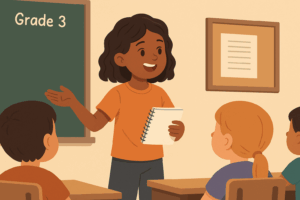Exploring Narrative Writing: Engaging 3rd Graders Through Storytelling
Key Takeaways:
Narrative writing helps third graders enhance their language skills and stimulates their imagination and creativity. Storytelling is crucial in developing empathy and understanding of others’ perspectives. Implementing practical narrative writing exercises in the classroom can improve student engagement and motivation.
Table of Contents:
- Introduction
- The Importance of Narrative Writing
- Core Components of a Good Story
- Techniques to Engage 3rd Graders
- Understanding the Writing Process
- Story Ideas to Inspire Young Minds
- Assessing Narrative Writing
- Bringing Stories to Life
Introduction
Narrative writing is a powerful tool that can ignite the imagination and creativity of young learners. For third graders, the storytelling journey enhances their writing skills and helps them comprehend the world in new ways. Through storytelling, students learn to express their thoughts, craft vivid images with words, and share experiences that are uniquely their own.

For many, the first foray into storytelling occurs through bedtime or animated television tales. As children enter the classroom, narrative writing becomes essential to their educational journey. Here, students move from being passive listeners to active creators, using their imaginations to build worlds and characters that communicate their feelings, observations, and hopes. Narrative writing is a gateway to enhancing linguistic abilities and an avenue for self-discovery and expression.
The Importance of Narrative Writing
Narrative writing is instrumental in nurturing a child’s ability to communicate effectively. Through crafting stories, third graders practice structuring their thoughts coherently, which is a fundamental academic and social skill. Additionally, storytelling fosters empathy; by creating characters and scenarios, students invest emotionally in their creations and gain insight into different perspectives. Encouraging children to start learning now through storytelling encourages engagement and aids in overcoming the fear of expression, unlocking a passion for words that can last a lifetime.
Core Components of a Good Story
A well-crafted narrative involves several key components that guide young writers in channeling their creativity effectively. These elements comprise character, setting, plot, conflict, and resolution. Characters are the heart of any story, serving as the conduits through which readers experience the narrative. A vivid setting provides the backdrop that anchors the narrative’s actions, giving readers a sense of time and place. The plot, or storyline, acts as the roadmap of narrative events, filled with conflicts that challenge the characters and engage the audience. Finally, the resolution provides closure, ensuring that learners master the art of concluding their stories thoughtfully.
Techniques to Engage 3rd Graders
Engaging third graders in narrative writing involves tapping into their innate curiosity and imagination. Creating a dynamic classroom environment where stories can flourish is essential. Teachers can kickstart the journey with stimulating prompts, encouraging students to brainstorm ideas. Introducing visual aids like story maps or storyboards also helps young writers visualize their thoughts before putting pen to paper. Role-playing exercises allow students to act out scenarios and dialogue, enhancing their understanding of characters’ emotions and motivations. Additionally, collaborative storytelling activities allow students to build stories together, fostering a sense of community and teamwork.
Understanding the Writing Process
The writing process is a structured guide that helps students transform their ideas into polished narratives. It comprises five stages: prewriting, drafting, revising, editing, and publishing. Prewriting involves brainstorming and organizing ideas; students may use diagrams or lists to jot down thoughts. Drafting is the phase where writers create the first version of their story, prioritizing getting ideas on paper over perfection. Revising involves refining the story by focusing on content and structure, ensuring the narrative flows logically. Editing entails correcting grammatical errors and ensuring clarity. Finally, publishing allows students to share their completed stories with peers, boosting confidence and encouraging pride in their work.
Story Ideas to Inspire Young Minds
Sparking creativity in third graders can be as simple as presenting a few intriguing story starters. For instance, a prompt like “Imagine a day when animals could talk—what conversations would you have?” can lead to imaginative tales rich with character dialogues. Adventures in fantastical lands, like a journey to a planet made entirely of candy, allow young writers to stretch their descriptive skills. Everyday scenarios, such as losing a favorite toy or making a new friend, provide relatable sparks for personal narratives. Encouraging students to draw from personal experiences while infusing their stories with a dose of fantasy ensures that narrative writing remains a captivating and accessible pursuit.
Assessing Narrative Writing
Evaluation of narrative writing in third graders should focus on storytelling’s creative and technical aspects. Teachers can use rubrics that assess components like idea development, organization, voice, and grammar. It’s vital to provide constructive feedback highlighting strengths while guiding students on areas for improvement. Encouragement can bolster confidence and motivate students to refine their skills further. Peer review sessions can also introduce students to different styles and perspectives, further enriching their narrative capabilities. Through these evaluations, students learn the value of revising and the impact of feedback on growing as writers.
Bringing Stories to Life
Narrative writing transports children to worlds where their imaginations reign supreme. Educators play a transformative role in shaping young minds by fostering an environment where creativity and expression are celebrated. Storytelling is a gateway to literacy, empathy, creativity, and critical thinking. As third graders explore the art of narrative writing, they gain invaluable skills that extend beyond the classroom, equipping them with the tools to share their voices with the world. Ultimately, by bringing stories to life, we celebrate the power of imagination and its profound ability to connect us all.

